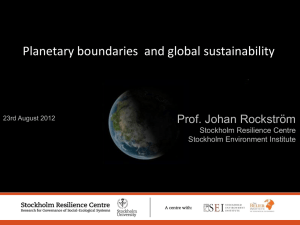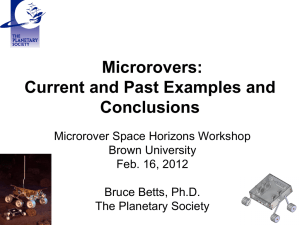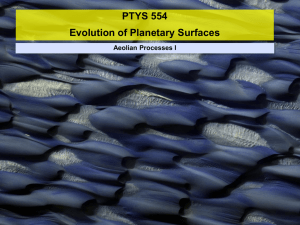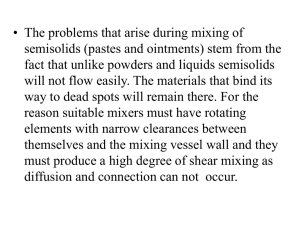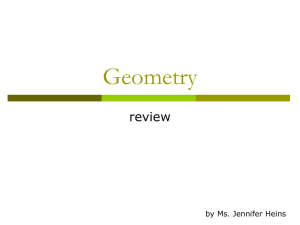Forming Planetary Crusts II - Lunar and Planetary Laboratory
advertisement
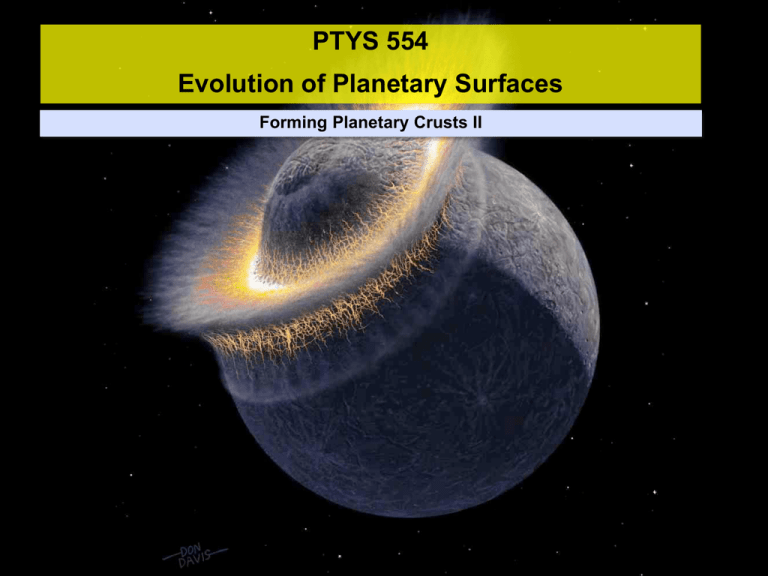
PTYS 554 Evolution of Planetary Surfaces Forming Planetary Crusts II PYTS 554 – Forming Planetary Crusts II Forming Planetary Crusts I Forming Planetary Crusts II Tour of planetary surfaces Terrestrial planet formation Differentiation and timing constraints Giant impacts and the end of accretion Magma oceans and primary crust formation KREEP Late veneers and terrestrial planet water Forming Planetary Crusts III One-plate planets vs. plate tectonics Recycling crust Plate tectonic changes over the Hadean and Archean 2 PYTS 554 – Forming Planetary Crusts II The first few 107 years to 108 years Kleine et al., 2009 T0 = 4568.2 ± 0.6 Myr formation of the CAIs Rapid formation of planetesimals < 1Myr Intense Al26 heating Melting and differentiation into iron meteorite parent bodies Formation of Chondrules and Chrondrites a few Myr later No differentiation due to lower 26Al levels Vesta-like bodies formed with volcanic activity in progress Gas disk dissipates ~10Myr Mars in ~10 Myr Silicate differentiation ~40 Myr Earth in ~30-100Myr Ends with the moon-forming impact, 50-150Myr At 163Myr Earth has a solid surface (zircons) Next phase (~50 Myr) involves giant impacts – the leading theory for… Stripping of Mercury’s silicate mantle Formation of Earth’s moon Formation of Mars topographic dichotomy Chambers et al., 2009 3 PYTS 554 – Forming Planetary Crusts II Overview of a rocky planet Starts as homogeneous mix of rock & iron Molten state allows differentiation Iron core cools and solidifies (not yet complete for the Earth) Millions of years Billions of years ~12,800 km 4 PYTS 554 – Forming Planetary Crusts II Planets start hot Gravitational potential energy of accreting mass Minimum energy delivered as velocity might be more than the escape velocity Spread over the planet’s surface increasing radius by ΔR Integrate over the planets radius to get total energy delivered Convert this energy to a temperature rise: M P CP DT = Ignore cooling for now DT = 3GM P2 E= 5RP 3GM P2 5RP 4Gpr 2 Rp = 6.28 ´10-10 Rp2 5CP ΔT for the Earth is very large >>> melting temperature ΔT ~ melting temperature means R~1000 km Objects bigger than large asteroids melt during accretion Differentiation also releases gravitational potential energy Amount depends on core/mantle density contrast and size of core Typically enough to melt the body Hf/W isotopes show differentiation essentially contemporaneous with accretion 5 PYTS 554 – Forming Planetary Crusts II Final phase High relative velocities Low gravitational focusing An inefficient process Takes ~ 100Myr Gas has disappeared now Jupiter and Saturn are fully formed Heavily affects outcome in the asteroid belt Determines what regions contribute the terrestrial planet material Final number, masses and positions of terrestrial planets are essentially random. 6 PYTS 554 – Forming Planetary Crusts II Three possible impacts giant impacts to consider… Formation of an iron-rich Mercury Formation of Earth’s Moon Mars Crustal dichotomy 7 PYTS 554 – Forming Planetary Crusts II Mercury’s Abnormal Interior Mercury’s uncompressed density (5.3 g cm-3) is much higher than any other terrestrial planet. For a fully differentiated core and mantle Core radius ~75% of the planet Core mass ~60% of the planet Larger values are possible if the core is not pure iron 3 possibilities Differences in aerodynamic drag between metal and silicate particles in the solar nebula. Differentiation and then boil-off of a silicate mantle from strong disk heating and vapor removal by the solar wind. Differentiation followed by a giant impact which can strip away most of the mantle. 8 PYTS 554 – Forming Planetary Crusts II 9 PYTS 554 – Forming Planetary Crusts II Basic story Mercury forms and differentiates Proto mercury is 2.25 times the mass of the current planet Impactor is ~1/6 of the mass Fast, head-on, collision needed to strip off mantle material In contrast to slow oblique collisions at Earth and Mars Head on collisions are less likely 10 PYTS 554 – Forming Planetary Crusts II Impact timescale A few hours to reform the iron rich Mercury Magma ocean certain Mercury must avoid re-accreting debris Half-life of debris is ~2 Myr Poynting-Robertson drag Dynamical models suggest Mercury can reaccumulate some small fraction of its old silicate material No samples means no constraints Benz et al., 2007 11 PYTS 554 – Forming Planetary Crusts II Formation of the Moon Facts to consider Moon depleted in iron & volatile substances Bulk Earth 30% iron (mostly core) Bulk Moon 8-10% iron (mostly in mantle FeO) Oxygen isotope ratios similar to Earth Moon doesn’t orbit in Earth’s equatorial plane Orbital solutions show that original inclination was close to 10 degrees Angular momentum of Earth-Moon system is anomalously high Corresponds to spinning an isolated Earth in 4 hrs Geochemical evidence for magma ocean Floating anorthosite Uniform age of highland material – more on this later 12 PYTS 554 – Forming Planetary Crusts II Possible theories (that didn’t work) Earth and Moon co-accreted Earth split into two pieces Spinning so fast that it broke apart (fission) …but the Moon doesn’t orbit in Earth’s equatorial plane …and present day angular momentum isn’t high enough Capture of passing body Explains oxygen isotopes Doesn’t explain iron and volatile depletion Earth captures an independently formed moon as it passes nearby Pretty much a dynamical miracle (Very hard to dissipate enough energy to capture) Doesn’t explain oxygen isotope similarity to Earth Current paradigm is Giant impact Earth close to final size Mars-sized impactor Both bodies already differentiated Both bodies formed at ~1 AU 13 PYTS 554 – Forming Planetary Crusts II 14 Free parameters Late vs Early (mass of proto-Earth) Early accretion poses compositional problem Mass ratio ~9:1 for late accretion ~Mars-sized impactor Impact parameter Controls angular momentum of final system Values 0.7-0.8 Rearth work best Most probable impact angle is 45° (b~0.707Rearth) Canup, 2004 Approach velocity Minimum is escape velocity Best results for v/vesc ~ 1.1 b PYTS 554 – Forming Planetary Crusts II 15 Canup, 2004 PYTS 554 – Forming Planetary Crusts II 16 Canup, 2004 PYTS 554 – Forming Planetary Crusts II 17 Isotopic ratios may have equilibrated through vapor cloud Canup, 2004 PYTS 554 – Forming Planetary Crusts II 18 PYTS 554 – Forming Planetary Crusts II 19 PYTS 554 – Forming Planetary Crusts II Most material in the lunar disk comes from the impacting body Still several 1000K Enough to remove volatile elements and water Cores of bodies merge Canup, 2004 Yellows/greens Isotopic ratios shouldn’t match without re-equilibration Temperature of material that goes into the moon is coolest 20 In the Earth PYTS 554 – Forming Planetary Crusts II Disks are 1.5-2 lunar masses Formation of a lunar sized body is possible in months 21 Tidal forces > self-gravity when inside the Roche limit ~2.9 Rearth for lunar density material Conservation of angular momentum Kokubo et al., 2000 Moon ~15x times closer Earth’s rotation ~3.9x faster (~6 hours) Tides have removed some of this angular momentum Moon drifts outwards aR ~ 2.9 Rearth Tk ~ 7 hours Optimum place to form moon is just outside this limit where disk is thickest From disk interaction From terrestrial tides PYTS 554 – Forming Planetary Crusts II Timeline constraints? Hf/W put the impact at >50Myr after CAIs Anorthosite Sm/Nd 112 ± 40 Myr formation of lunar crust Norman et al. 2003 KREEP (Zircon Pb/Pb) 150 Myr Nemchin et al. 2009 Whole moon Rb/Sr 90 ± 20 Myr Halliday 2008 Earths magma ocean gone by 163Myr Zircons again 22 PYTS 554 – Forming Planetary Crusts II 23 Mars: Crustal Dichotomy Northern and southern hemispheres of Mars are very distinct: North South Low elevation Few Craters – Young Smooth terrain Thin Crust No Magnetized rock High elevation Heavily cratered – Old Rough terrain Thick crust Magnetized rock Dichotomy boundary mostly follows a great circle, but is interrupted by Tharsis No gravity signal associated with the dichotomy boundary - compensated Theories on how to form a dichotomy: Giant impact Several large basins Degree 1 convection cell Early plate tectonics Zuber et al., 2000 PYTS 554 – Forming Planetary Crusts II Despite all this the difference is only skin deep Buried impact basins in the northern hemisphere have been mapped Before this burial the northern and southern hemispheres were indistinguishable in age Rules out Earth-style plate tectonics Northern hemisphere is a thinly covered version of the southern hemisphere Mantled by 1-2 km of material (sediments and volcanic flows) Frey et al., 200? 24 PYTS 554 – Forming Planetary Crusts II 25 Borealis basin 208E, 67N 4250-5300 km in radius Shares slope break with at ~1.5 basin radii with other basins Largest impact structure in the solar system Andrews-Hanna et al., 2008 PYTS 554 – Forming Planetary Crusts II Hydrocode modeling of a vertical and oblique impacts 3x1029 kms-1 J impact, 6-10 at 30-60° No global melting – melt layer 10s of km thick within basin Northern crust extracted from already depleted mantle 26 Marinova et al., 2008 Nimmo et al., 2008 May correspond to Shergottites formed from a depleted reservoir 100Myr after most SNCs PYTS 554 – Forming Planetary Crusts II Giant Impacts make Magma Oceans Lunar magma ocean was probably at least a few hundred km thick Apollo 11 returned highland fragments, first suggestion of Magma ocean Idea since extended to other terrestrial planets A melt has a bulk chemical composition, but no crystals Minerals are mechanically separable crystals with a distinct composition Terrestrial planets are dominated by silicon-oxygen based minerals – silicates Silicate rocks are built from SiO4 tetrahedra 27 PYTS 554 – Forming Planetary Crusts II Depending on how Oxygen is shared Olivine Isolated tetrahedra joined by cations (Mg, Fe) (Mg,Fe)2SiO4 (forsterite, fayalite) Pyroxene Chains of tetrahedra sharing 2 Oxygen atoms (Mg, Fe) SiO3 (orthopyroxenes) (Ca, Mg, Fe) SiO3 (clinopyroxenes) Feldspars Framework where all 4 oxygen atoms are shared 28 PYTS 554 – Forming Planetary Crusts II What happens when you cool a melt? Bowens reaction series Minerals begin to condense out in a certain order Dense minerals sink e.g. Olivine (Mg,Fe)2SiO4 Buoyant minerals rise e.g. Anorthite Ca Al2Si2O8 ‘Undesirable’ elements get more concentrated in remaining liquid Potassium (K), Rare Earth Elements (REE), Phosphorus (P) The reverse happens when you melt a solid More on that in the volcanism lectures 29 PYTS 554 – Forming Planetary Crusts II Original planetary crusts from silicate differentiation Calcium-rich plagioclase feldspar (anorthosite) Floats in an anhydrous melt – moon, mercury? Sinks in a hydrated melt – Earth, Mars, Venus Unstable at high pressures – so sinking anorthosite is doomed Lunar Case Olivine and Pyroxene Sinks in shallow magma ocean Undesirables form KREEP layer Non-uniformly distributed Earth/Venus/Mars Olivine rains out Remaining composition is called Basalt is a broad term (to be expounded upon in the volcanism lectures!) Variations in water content Variations in alkali metal content Variations in silica content These are initial crusts that will be heavily modified by: Stripping by Giant Impacts Plate Tectonics Volcanism 30 Ultrabasic Primative Fe poor Light Less-dense PYTS 554 – Forming Planetary Crusts II Basic Fe rich Dark Dense 31 Acidic Evolved PYTS 554 – Forming Planetary Crusts II End result is a chemically distinct skin of rock called a crust 32 10s of km thick Density ~3000 kg m-3 Two main consequences of crustal formation Mantles depleted Upper mantle is more Olivine rich Crusts enriched in isotopes The ‘undesirables’ are concentrated in the crust Radiogenic isotopes (heat sources ) mostly in the crust Mantle rocks Average PYTS 554 – Forming Planetary Crusts II 33 The Moon has the ‘predicted’ anorthosite crust Some resurfaced by later basaltic flows Unexplained: crustal thickness variation Non-uniform KREEP distribution 3.8 Ga 3.1 Ga Mercury should have lost any original anorthosite crust in its giant impact Messenger indicates lower Ca/Si and Al/Si than the lunar highlands …but abundant volatile species are a problem to explain Very low Fe and Ti abundances Nittler et al., 2011 PYTS 554 – Forming Planetary Crusts II 34 Venus rock composition Sampled in only 7 locations by Soviet landers Composition consistent with low-silica basalt Exposed crust is <1 Gyr old though Venera 14 PYTS 554 – Forming Planetary Crusts II Earth’s crust is continuously recycled by plate tectonics and so we don’t see any original crust But we can see production of basaltic crust ongoing today Characteristic stratigraphic sequence: Gabbro (large grained basalt) Sheeted dikes Each sheet was the wall of the inner ridge Pillow basalts Blobs of basalt that are quickly quenched Ocean sediments Fine-grained muds Called an ophiolite sequence Can be obducted onto a continental setting Isua supracrustal belt – southern Greenland 3.8 Ga 35 PYTS 554 – Forming Planetary Crusts II Martian in-situ and orbital measurements Crust dominated by basalt With a thin weathered coating McSween et al., 2009 36 PYTS 554 – Forming Planetary Crusts II Hydrocode modeling of a vertical and oblique impacts 3x1029 kms-1 J impact, 6-10 at 30-60° No global melting – melt layer 10s of km thick within basin Northern crust extracted from already depleted mantle 37 Marinova et al., 2008 Nimmo et al., 2008 May correspond to Shergottites formed from a depleted reservoir 100Myr after most SNCs PYTS 554 – Forming Planetary Crusts II In decreasing order of severity… Mercury – head-on, high velocity, collision Total planetary disruption Earth – grazing, low velocity, collision Forms very large Moon Global magma oceans on both bodies Mars – grazing, low velocity, collision Forms hemispheric dichotomy A baby magma ocean, no large moon Vesta Distorted shape of object Ejected crustal and mantle samples to Earth Giant impacts may have had other roles Formation of Pluto’s moons Rotation of Venus 38 PYTS 554 – Forming Planetary Crusts II Explaining Earth’s water is a problem Raymond et al., 2009 Best done with Jupiter and Saturn on circular orbits Explaining a small Mars is a problem Best done with Jupiter and Saturn on eccentric orbits, e ~ 0.1 Inconsistent with Nice model for later giant planet migration 39 PYTS 554 – Forming Planetary Crusts II Earth’s water Possible Sources 1 Earth ocean ~ 1.4 x 1021 Kg Estimates of Earth’s water content of ~5 oceans, about 0.1% MEarth Inner nebula was too hot to allow water or hydrous minerals Adsorbed on dust grains at 1 AU Comets Asteroids (either ice or as hydrated minerals) Constraints D/H of Earth’s water Late veneer of highly siderophile elements Moon is (mostly) dry Surface water after moon-formation 40 PYTS 554 – Forming Planetary Crusts II 41 D/H rules out comets But only 3 Oort cloud comets have been measured Condensed near Jupiter’s current position Bulk comet might be different than its coma Jupiter family comets might have a different D/H Condensed in Kuiper belt Mars D/H matches comets Lack of crustal recycling? Asteroids match Earth’s D/H Only Carbonaceous Chondrites have significant water But addition of these asteroids would produce the wrong Os isotopes Earth has a late veneer of highly siderophile elements (added post differentiation) At ~0.003 of CI abundances (but in CI ratios) Ordinary chondrites are an isotopic match Requires a ~1% MEarth addition after the moon forms But late veneer and water delivery could come from different sources Drake, 2005 PYTS 554 – Forming Planetary Crusts II Adsorbed onto dust grains? Simulated adsorption onto forsterite grains shows a few oceans can be stored in this way …but, not all adsorption sites would contain water (e.g. competition from H2) Ordinary chondrites are not hydrated… Muralidharan et al., 2008 42
